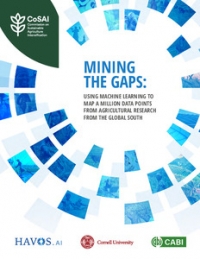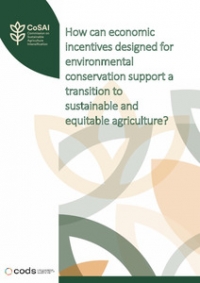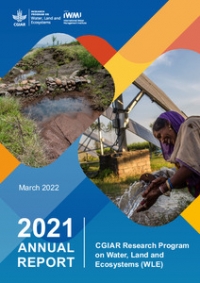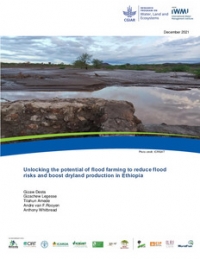This post is part of the “Science on the Pulse” series - a two-part quarterly review highlighting the latest literature on ecosystem services and resilience.
You are what you eat.
We’ve been engaging increasingly with the health sector to explore the relationship between biodiversity, environmental health and human well-being – particularly through our collaboration on multifunctional landscapes with EAT. Stay tuned for this CIAT-hosted EATx event occurring on October 30th which features a Latin American Perspective on food, health, and the environment. It’s a fascinating realm with plenty of new and exciting ideas.

Bioversity is currently engaged in a debate on the role of biodiversity and dietary diversity on human nutrition in small-holder production systems.
Some work we noted on this front includes a new “global biogeography of human infectious diseases” published in PNAS. What surprised the researchers was that despite significant trends in globalization, disease distribution remains largely biogeographical, with strong indicators of ecological barriers limiting the spread of diseases globally. There’s room here for much more process-based work on landscape change and connectivity of disease spread which we feel would be of great relevance to (and collaboration between) agricultural pests and diseases, in conjunction with human ones.
Another aspect of the human-environmental health relationship that we have been analyzing is the influence of dietary diversity on human health and its effect on feedbacks to agricultural systems, landscape diversity and multifunctionality. This current debate on dietary guidelines is well described by Merrigan and colleagues in this Policy Forum piece on “Designing a sustainable diet”.
The article draws attention to the potentially powerful force that including aspects of sustainable food production in dietary guidelines could play in aiding agricultural policy. For example, should a dietary guideline make recommendations on reducing red meat intake for both a human health (reducing coronary heart disease), as well as environmental health (methane emissions and deforestation) perspective? As we said above, the increased presence of the health sector in agricultural and environmental policy is shaking things up, and it’s getting interesting.
Well I’ll be dammed!
On environmental health, we flag the work of our colleague Matthew McCartney of IWMI considering the impact of dam construction on malarial vectors as an area of interest as well. The study finds that there are at least 1.1 million cases of malaria that are associated with communities located in proximity of large dams. We’re working with NatCap to include a malaria model in InVest - let us know if there are any avenues you think we need to pursue on this front.
Negative impacts of land use on water quality, and associated human health problems through direct consumption or contamination of the food chain, can be reduced or averted by ecosystem filtration and retention of pollutants. Riparian buffers seem to be the darling of environmental interventions in this respect, highlighted for the plethora of benefits that they can provide, and prevalent in many national policies. They were highlighted in several research articles recently, improving our capacity to make statements as to their contribution in providing multiple ecosystem services and conservation functions.
For example Connolly et al. indicate that while nitrogen contamination can be mitigated by reducing fertilizer use, and that NOx concentration increases in proportion to the upstream agricultural area, riparian buffers were able to provide some buffering, though not enough to meet water quality guidelines. Changes in agricultural practices need to accompany buffer vegetation to achieve desired impacts on water quality.
Cole et al. focused on the insects found in riparian buffers rather than on water and found that riparian margins were effective at supporting greater pollinator abundance than in adjacent grasslands. The width of the buffer increased pollinator abundance as well. Also see one more riparian buffer case from Giam et al. who published in Conservation Biology on the role of riparian buffers in mitigating the impacts of oil palm monocultures in freshwater fish in Southeast Asia. This team again found that maintaining such buffers rather effectively mitigated the loss of freshwater fish diversity in the absence of buffers.
Something is in the air, quite literally.
While we often focus on the impact of agriculture on water quality - its impact on air quality is what has been drawing attention in both the press and the research literature.
Lelieveld and colleagues published a global assessment of the contribution of outdoor air pollution sources to premature mortality in the September 17 issue of Nature. They highlight that poor air quality leads to more than 3.3 million premature deaths globally. Agriculture plays a surprisingly large role here and is the biggest source of outdoor air quality related premature deaths in China, Russia, the United States and Europe.
The authors explain that these high numbers come from the NH3 emissions from fertilizer use and domesticated animals. NH3 impacts air quality through several multiphase pathways, through the authors specifically highlight how NH3 is often limiting in particulate matter formation, and thus a reduction in NH3 use could make an important contribution to air quality. The study includes a category on biomass burning, which when looking at the map appears to be closely related to forest clearing in the Amazon and Congo basins. Biomass burning accounts for 5% of the premature mortality globally and is particularly high in Indonesia (27%).
Is health policy a driver of change in agricultural practices?
Our own research with the The Economics of Ecosystem and Biodiversity for Agriculture and Food (TEEBAgFood) focusing on California rice production systems highlighted how the air quality concerns over rice straw burning in the Central Valley of California forced a burning ban and a shift to winter flooding as a means of eliminating rice straw. It’s a nice demonstration of the influence of human health on agricultural practices. The California story ends well, the shift in practices converted many rice fields to rich wetlands over the winter - Cal Rice now provides nearly half of the wetland habitat for the state and farmers are quite proud of it. For those whose imagine of California as a desert landscape, we’ll highlight that pre-European colonization, California’s Central valley was a vast wetland ecosystem with the largest lake west of the Mississippi.
The California work causes us to reflect on news from Indonesia of agricultural fires forcing the evacuation of infants from impacted areas, and the multi-day closure of airports. This news begs the question whether as in California, health policy might be the driving force to changing agricultural practices in the region away from burning and on how agricultural and environmental research can team up with health policy to provide sustainable solutions.























Comments
Nice article, Fabrice Declerck, would you like to include ecological freshwater aquaculture to the Agrobiodiversity and Ecosystem Services list?
Hi Laurence, I would be happy to. Is there a specific email that you are referring to? We're also quite interested in the ecosystem service of inland fisheries such as the Tonle Sap and the Barotse floodplain which we find particularly important sources of both provisioning and regulating services provided by flood pulses, but extremely threatened by desires to for more regulated systems.
Very informative, especially the research study which was done to evaluate the crop production as well the soil fertility. A new approach is am aware of is biofield energy treatment which is also known for its impact on crop production as well on improving soil fertility, I read about this technique here:
https://trivediscience.com/publications/agriculture-publications/impact-o...
& https://www.omicsonline.org/author-profile/Mahendra_Kumar_Trivedi/